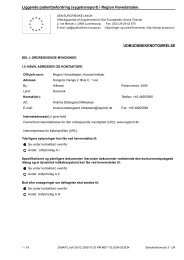Territorial Review Copenhagen - Region Hovedstaden
Territorial Review Copenhagen - Region Hovedstaden
Territorial Review Copenhagen - Region Hovedstaden
Create successful ePaper yourself
Turn your PDF publications into a flip-book with our unique Google optimized e-Paper software.
193<br />
2.8. Conclusion<br />
There appear to be several strategies rather than one common strategic<br />
vision for <strong>Copenhagen</strong>. Although these visions do not conflict with each<br />
other, they do not provide clear priorities on how to improve <strong>Copenhagen</strong>‘s<br />
competitiveness. An impressive number of strategic policy documents have<br />
been published over the last years, at the national, regional and city level.<br />
The processes leading up to these documents have increased the<br />
involvement of strategic actors in <strong>Copenhagen</strong> and resulted in some form of<br />
alignment. The relative lack of focus in these strategic visions, however, is a<br />
lost opportunity to create the sense of urgency needed to mobilise more<br />
actors, such as the national government, to strengthen the key determinants<br />
of <strong>Copenhagen</strong>‘s competitiveness.<br />
Arguably the most important determinant in <strong>Copenhagen</strong>‘s competitive<br />
position is the availability of highly skilled people. Policies in several fields<br />
could be more active and better geared towards this aim. Several actors have<br />
responsibilities in this area: national government, regional governments,<br />
universities and businesses. Policy areas that merit attention include student<br />
grants, less segregation at school level, enterprise-based training of<br />
immigrants, internationalisation of higher education and more pro-active<br />
attraction of highly skilled people through a more competitive international<br />
talent attraction package.<br />
Several policies could contribute to making an attractive case for<br />
<strong>Copenhagen</strong>. Housing policies can ensure that housing remains attractive<br />
and affordable; also for workers that provide key public services to the city.<br />
Infrastructure policies can make sure that proximity and relative limited<br />
congestion continue to be an asset for the region. Fine-tuning of<br />
environmental policies could realise <strong>Copenhagen</strong>‘s ambition to become the<br />
green capital of Europe and provide urban amenities such as clean water and<br />
air. Cultural policies and increased ambitions in organising events could<br />
bring more cultural amenities that could be appreciated by high-skilled<br />
labour. Innovation and entrepreneurship policies continue to be important in<br />
increasing economic dynamism and the knowledge-intensive environment<br />
that can contribute to productivity.<br />
National policies impose considerable constraints on <strong>Copenhagen</strong>. Many<br />
of the challenges for <strong>Copenhagen</strong>‘s future competitiveness are directly or<br />
indirectly related to national policy. National immigration and tax policy<br />
have had an impact on <strong>Copenhagen</strong>‘s attractiveness to high-skilled foreign<br />
labour, and housing legislation has made it difficult to solve housing<br />
affordability problems. Danish-Swedish differences in national legislation<br />
hinder further functional integration of the Øresund <strong>Region</strong>, and the national<br />
parliament has yet to agree to the introduction of local road pricing.

















